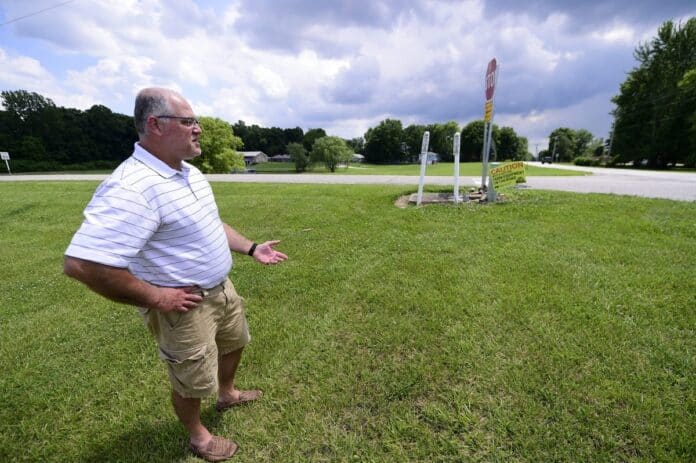
This story has been updated.
FORTVILLE — When a vehicle crash occurred right outside Mark Chatterson’s home, he was not surprised. Chatterson, who called 911 right away when he heard the collision on the morning of June 22, said he and his immediate neighbors have gotten used to dialing the number.
Chatterson, who lives near the intersection of Fortville Pike and County Road 600N, said three accidents have occurred there in the past month and a half.
“It shouldn’t take someone dying for the county to do something,” Chatterson said.
[sc:text-divider text-divider-title=”Story continues below gallery” ]
Click here to purchase photos from this galleryThe accident left the driver of one of the vehicles, Alicia Scudder, 23, badly injured. Fog may have been a factor; visibility at the intersection at the time was poor, police said. Home security footage of the scene showed that the crash occurred when Scudder’s vehicle, which had stopped at a stop sign on 600N, pulled into the path of an oncoming pickup truck on Fortville Pike, which did not have to stop at the intersection.
Chatterson would like the county to install a four-way stop sign at the intersection. He and some of his neighbors have asked the Hancock County Highway Department to make changes. He said a speed-limit change would likely not be enough to make a difference, since drivers frequently exceed the current 50 mph limit.
“It’s high-speed, and I don’t think a speed-limit sign will change anything,” Chatterson said.
Many people who feel an intersection near their home is especially accident-prone contact the highway department, asking for changes to be made. But in many cases, it’s not as simple as adding more stop signs, which experts say can actually increase the danger at rural intersections.
Gary Pool, the Hancock County engineer, mentioned during a county commissioners meeting earlier this week that he had heard from multiple people about the intersection. Earlier, Pool told the Daily Reporter he was keeping an eye on the intersection, but he said he did not have reason to believe it was exceptionally dangerous or accident-prone.
“Generally, everybody wants a four-way stop by their house,” Pool said.
The Hancock County Highway Department keeps records of accidents in the county using reports from local law enforcement as well as the Automated Reporting Information Exchange System, a database that tracks vehicle crash data for all of Indiana.
Pool said records showed four accidents that led to injury have occurred at the Fortville Pike/600N intersection in the past ten years, none of them fatal. Nine accidents resulting in property damage were recorded during that period.
Pool warned that adding additional stop signs without sufficient cause for the change could actually lead to more accidents.
“Putting in a four-way stop just because we feel like it is incredibly dangerous,” Pool said.
That’s because drivers unaccustomed to stopping at an intersection might drive right past a stop sign before mentally processing that it’s there.
The situation with Fortville Pike is not unusual. The county received similar complaints last year about the intersection of County Road 200S and County Road 500W, also known as Gem Road, after a fatal accident involving a motorcyclist. That was the second fatality there in about the past five years.
As is the case on Fortville Pike, traffic on Gem Road doesn’t have to stop. County Road 200S is marked with a stop sign; another sign several hundred feet in advance; and rumble strips in the pavement, all intended to warn drivers they are approaching a dangerous intersection. Pool said at the time that changing the intersection to a four-way stop would also be dangerous and likely lead to more deaths.
Lt. Charles Murnan, the traffic safety officer for the Greenfield Police Department, also said it can be difficult to know when changes need to be made to an intersection.
“We have a list of streets that we watch that we know are kind of problem areas,” he said.
Murnan tracks vehicle accidents in the city of Greenfield on a spreadsheet, using police reports and data from the Automated Reporting Information Exchange System. Each year, he makes a report to the five-person Traffic Safety Committee on patterns in crashes and problematic roads or intersections. If the committee feels that a change in signage is necessary, they make a recommendation to the Greenfield City Council.
Adding a four-way stop to a previously two-way intersection does have risks, he said, and does not always make an intersection safer. However, it depends on the location.
The Hancock County Highway Department every winter conducts an assessment of its most crash-prone intersections. It uses a hazard analysis program to assess which intersections need to undergo changes. The analysis uses crash statistics to measure the risk and cost posed by possible changes.
One alternative for such troublesome crossings might be roundabouts. Pool said he wishes more resources were available to build more in Hancock County. However, installing one costs about $1.5 million, and the county must compete with the Indianapolis area for traffic safety grant dollars. Thanks to this year’s economic downturn, Pool said, funding will probably be even harder to come by in the near future.
Pool said the highway department will study the intersection of Fortville Pike and County Road 600N.
“We’ve made huge improvements in intersection safety,” Pool said of efforts countywide, which include installing rumble strips on many two-way intersections. However, he noted, no intersection can ever be 100% safe — because people are driving through it.
